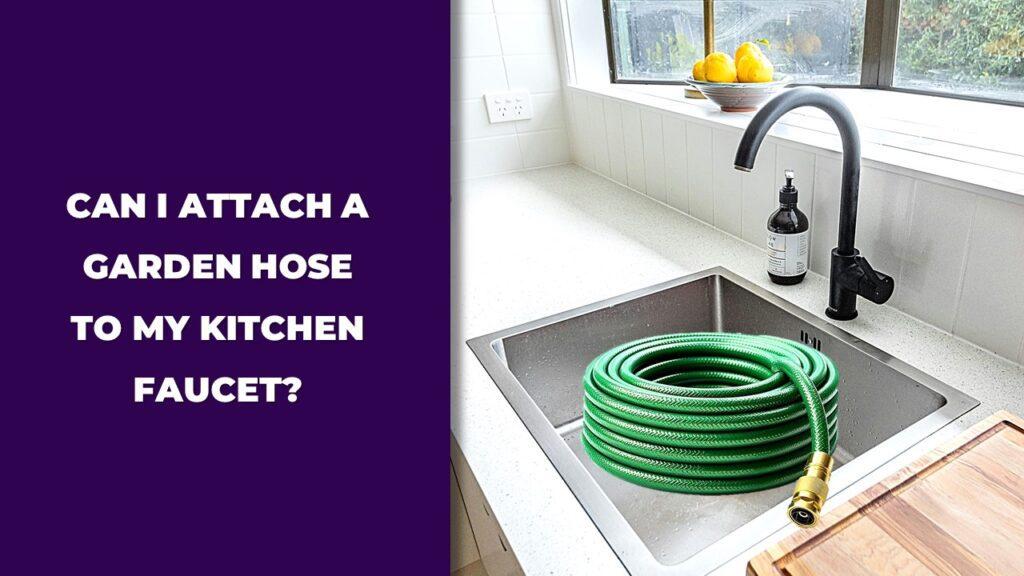
Yes, you can attach a garden hose to your kitchen faucet, but you’ll need a faucet adapter to make it work. The adapter screws onto your faucet where the aerator used to be. Once that’s on, you can connect your hose. It’s a simple fix, but you’ll want to make sure the adapter fits your faucet properly and that the connections are tight, so you don’t end up with leaks or water spraying all over the place.
I’ll walk you through what you need, how to find the right adapter, and a step-by-step guide for hooking everything up. I’ll also throw in some tips on handling common problems and when you might want to rethink this setup.
Why Would You Want to Attach a Garden Hose to a Kitchen Faucet?
You might want to attach a garden hose to your kitchen faucet when you need an indoor water source for tasks like watering plants, filling large buckets, washing pets, or cleaning areas far from an outdoor spigot. It’s a handy workaround when outdoor access isn’t possible or when you’re dealing with tight spaces.
Many homes, especially apartments or older houses, don’t have outdoor faucets. If you’ve got indoor plants to water, pets to bathe, or need a stronger stream of water in the garage, connecting a hose to your kitchen sink makes the job easier. Sometimes it’s the only option when the outside faucet is frozen in winter or broken.
This setup is also helpful for hobbyists—think hydroponics, brewing, or aquarium cleaning. It gives you flexibility, and with the right adapter, you won’t have to deal with leaks or messes. You get the job done without having to run hoses through windows or dragging buckets from the bathroom.
What You’ll Need Before Attaching a Hose to Your Kitchen Faucet
To attach a garden hose to your kitchen faucet, you’ll need a faucet adapter that matches the thread size and type of your faucet. The adapter acts as a bridge between the faucet spout and the hose connector, letting you create a watertight seal. You’ll also need a few basic tools to make the job smooth and safe.
Tools and Materials
- Faucet adapter: The key part that connects your faucet to the hose
- Rubber washer or gasket: Helps prevent leaks at the connection
- Adjustable wrench or pliers: For loosening and tightening the aerator and adapter
- Teflon tape (optional): For sealing threads and preventing drips
- Aerator removal tool: Handy for cache-style faucets with hidden aerators
- Measuring tape: To check faucet thread size if unsure
How to Choose the Right Faucet Adapter
Choosing the right faucet adapter depends on your faucet’s size and thread type. Start by checking if your faucet has male threads (on the outside) or female threads (inside). Most kitchen faucets have either a 15/16″-27 male or 55/64″-27 female thread, but it’s always smart to double-check.
If your faucet has a hidden aerator, look for a cache aerator adapter that fits flush inside the spout. Take your aerator to a hardware store if you’re not sure—many stores will help you match it. And if you plan to use the hose for tasks like filling aquariums or brewing, consider a vacuum breaker adapter for added safety.
Once you’ve got the right adapter, you’re ready to connect the hose. Keep it simple, make sure the connections are snug, and you’ll have a leak-free setup for all sorts of indoor tasks.
Step-By-Step Guide: How to Attach a Garden Hose to a Kitchen Faucet
Here is the step-by-step guide for connecting a garden hose to your kitchen faucet:
- Remove the aerator from the faucet spout
- Install the faucet adapter and check for a snug fit
- Connect the garden hose to the adapter, tighten it, and check for leaks
These simple steps let you use your kitchen faucet as a water source for a hose. Now, let’s dive into each step so you get it right the first time and avoid messy leaks or damage.
1. Remove the Aerator
The first thing you need to do is unscrew the aerator from the end of your kitchen faucet. That’s the small piece where the water comes out. If you’re lucky, you can do it by hand. If it’s stuck, wrap a cloth around it and use an adjustable wrench or pliers to turn it gently. Be careful not to scratch the faucet. For faucets with a hidden or “cache” aerator, you’ll need an aerator removal tool or a flathead screwdriver to pry it loose.
Once you remove the aerator, take a quick look at the threads. If the threads are on the outside, you’ve got a male faucet. If they’re on the inside, it’s a female faucet. Knowing this helps you pick the right adapter in the next step.
2. Install the Faucet Adapter
With the aerator off, it’s time to install the faucet adapter. The adapter is what allows your kitchen faucet and garden hose to connect properly. Check that the rubber washer is seated inside the adapter—this is what creates a watertight seal. Screw the adapter onto the faucet by hand. It should feel snug but don’t over-tighten it. If the threads feel rough or there’s a small leak after tightening, wrap a little Teflon tape around the faucet threads to help it seal better.
Adapters come in different sizes, so make sure yours matches your faucet. A universal adapter works in some cases, but it’s best to get the correct size and type for your faucet, whether it’s a standard kitchen faucet, a cache faucet, or something unique.
3. Attach the Garden Hose
Now that the adapter is in place, attach the garden hose. Just like before, check for a rubber washer inside the hose connector—this helps prevent leaks. Screw the hose onto the adapter by hand until it feels tight. Don’t use a wrench on this part or you might damage the threads.
Once it’s connected, turn on the water slowly and watch for any drips. If you see leaks, tighten the connections a bit more. If the water pressure feels low or the hose leaks, double-check the gasket placement and that the hose is fully threaded onto the adapter. If it all looks good, you’re ready to use your hose indoors for whatever task you’ve got in mind.
Common Problems and Solutions
Attaching a garden hose to a kitchen faucet sounds easy, but sometimes things don’t go as planned. Here are a few common problems people run into and how to fix them.
Leaks at the Connection
Leaks often happen when the gasket isn’t seated right, or if the threads aren’t aligned properly. Before you tighten everything, make sure the rubber washer is in place inside both the adapter and the hose. If you see water dripping after connecting, gently tighten the connection by hand. If it still leaks, add a few wraps of Teflon tape to the threads. This helps fill in small gaps and create a better seal. Don’t crank down too hard—just firm and snug is enough to avoid damaging the faucet.
Low Water Pressure
If the water flow feels weak when using the hose, a few things could be causing it. First, check the faucet itself. Some kitchen faucets have flow restrictors built into the aerator, and if that’s still in place, it could be limiting water flow. Also, check the hose for any kinks or blockages. If the hose is long, there may be pressure loss over distance. Try using a shorter hose or removing any attachments that could restrict flow. If you need stronger pressure, connecting directly to an outdoor spigot (if possible) may work better.
Adapter Compatibility Issues
Not all faucets are created equal. If you’re struggling to find an adapter that fits your faucet, it’s likely because you have a unique thread size or a special faucet design. Cache-style faucets, for example, have hidden threads and require a special adapter. Take your aerator or faucet measurements to a hardware store to compare. Some adapters are universal, but they don’t always provide a perfect fit. When in doubt, talk to a plumber or check the manufacturer’s website for recommendations. Matching the adapter to your faucet properly will save you headaches down the road.
Safety Tips When Using a Hose Indoors
Using a garden hose indoors connected to a kitchen faucet is handy, but you need to keep a few safety tips in mind. Watch out for leaks, water pressure changes, and the risk of backflow, which can contaminate your water supply.
First off, always check your connections before turning on the water. A loose adapter or hose can cause water to spray everywhere, leaving you with a soaked kitchen and potential water damage. It’s a good idea to have towels nearby just in case.
If you’re using the hose to fill a tub, wash a pet, or water plants, never leave it unattended while the water is running. A small leak can quickly turn into a big mess. And if the hose end is submerged in water (like a bucket or tub), use a vacuum breaker to prevent dirty water from being sucked back into your home’s plumbing—this is a simple device that protects your drinking water from contamination.
Also, remember that kitchen faucets aren’t built for constant high-pressure hose use. Don’t over-tighten connections, and turn off the faucet when not in use to avoid stress on the faucet parts and possible leaks.
When to Avoid Connecting a Garden Hose to a Kitchen Faucet
You should avoid connecting a garden hose to a kitchen faucet when the faucet or adapter setup isn’t safe or practical. Not every faucet is built to handle the added weight and pressure of a hose.
Here are a few situations when it’s best to skip this setup:
- Weak or old faucet fittings: If your faucet is wobbly or feels loose, connecting a hose can make the problem worse.
- Hidden (cache) aerators: Some modern faucets have built-in aerators that don’t accept adapters without special tools or parts.
- High-flow tasks: If you need strong water pressure, like for washing a car or pressure washing, a kitchen faucet may not provide enough water flow.
- Backflow risk without protection: If you plan to submerge the hose in water (for example, filling a bucket or tub), you risk contaminating your water supply unless you use a vacuum breaker.
- Long-term use: Kitchen faucets aren’t designed to support a hose long-term. For regular or heavy-duty use, consider a dedicated utility sink or outdoor spigot.
Alternatives to Using a Hose with a Kitchen Faucet
If attaching a hose to your kitchen faucet doesn’t seem like the best option, there are other ways to get water where you need it. You can use a utility sink with a built-in hose connection, a portable water pump, or even a washing machine hookup.
A utility sink with a hose adapter is a solid long-term solution. These sinks are made to handle bigger jobs, and the faucet is built for heavy-duty use. If you often need water for cleaning or gardening tasks, installing a utility sink in a garage or basement can save time and prevent kitchen wear and tear.
Another option is a portable water pump. These devices draw water from a bucket or other source and can deliver it through a hose. This is handy if you’re working in an area without direct faucet access or need higher pressure than your faucet can provide.
Lastly, some people use the washing machine hookup as an alternative faucet. If your laundry area has a threaded spigot for the washer, you can temporarily attach a hose there. Just remember to remove the hose and reconnect the washer when you’re done to avoid any unexpected laundry mishaps.
Conclusion
Yes, you can attach a garden hose to your kitchen faucet, but it takes the right adapter and a careful setup. A faucet adapter is the key part that makes the connection work by replacing the aerator and providing the threads for the hose. This simple solution allows you to use your kitchen faucet for tasks like filling buckets, washing pets, or watering plants indoors.
Before you go ahead, make sure your faucet is in good condition and can handle the added weight and pressure of the hose. Check the thread size, choose the correct adapter, and follow the step-by-step process for a leak-free connection. Don’t forget to keep safety in mind—use a vacuum breaker when necessary and avoid leaving the hose running unattended.
If your kitchen faucet isn’t compatible, or you need a more permanent setup, consider other options like installing a utility sink with a hose connection or using a portable water pump. These alternatives can give you a safer, more reliable way to get the water where you need it.
Related FAQs
Can I use a garden hose indoors safely?
Yes, but it’s important to use a proper faucet adapter and check connections for leaks. Always monitor the hose when it’s in use to avoid flooding or water damage.
Do all kitchen faucets support adapters?
Not all faucets support adapters. Faucets with hidden (cache) aerators or non-standard threads may need special adapters, or they might not work at all.
Will connecting a hose damage my faucet?
It can, especially if the faucet is old, weak, or not designed to handle the added weight and pressure. Always check your faucet’s condition before attaching a hose.
What is a vacuum breaker, and why is it important?
A vacuum breaker is a device that prevents dirty water from flowing back into your clean water supply. It’s a simple safety tool that helps protect your drinking water from contamination.
Can I use the same hose for drinking water?
No, most garden hoses are not safe for drinking water. If you need a hose for potable water, look for one labeled as “drinking water safe” or “lead-free.”

Dylan Foster is a family man with years of hands-on experience in plumbing, household maintenance, and fixing everyday issues around the home. A former plumber, Dylan knows what it’s like to deal with tricky leaks, worn-out parts, and all the little problems that pop up in a house. From plumbing repairs to kitchen fixes and garden hose setups, he’s done it all. Dylan shares real-world solutions to help others keep their homes running smoothly and avoid costly mistakes.




